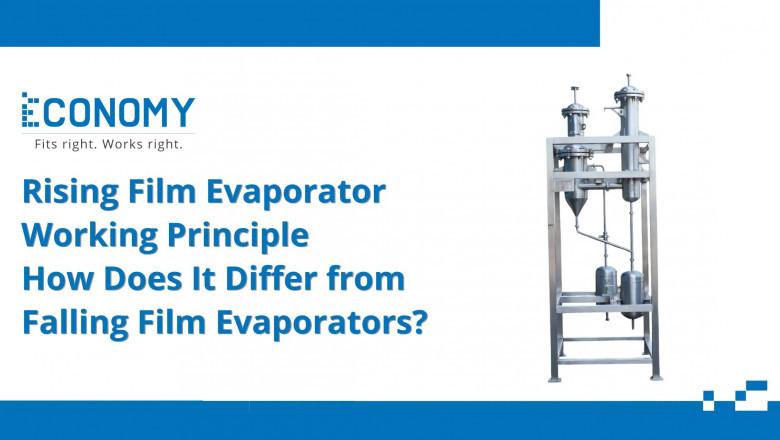Understanding Rising Film Evaporator Working Principle and Differences from Falling Film Evaporators
views
Understanding Rising Film Evaporator Working Principle and Differences from Falling Film Evaporators
Working Principle of Rising Film Evaporators
Rising film evaporators are widely used in various industries for efficient liquid concentration and evaporation. Their working principle is based on the thermosiphon effect, where the liquid feed enters the bottom of vertical tubes and begins to heat up. As the liquid absorbs heat, it starts to boil, and the vapor generated pushes the remaining liquid upwards, forming a thin film along the inner surface of the tubes. This rising film enhances heat transfer efficiency and prevents fouling due to the continuous movement of the liquid.
The vapor-liquid mixture exits at the top, where the vapor is separated, and the concentrated liquid is collected. Rising film evaporators are particularly effective for handling low-viscosity liquids and provide high evaporation rates due to rapid heat transfer.
Working Principle of Falling Film Evaporators
Falling film evaporators operate differently from rising film evaporators, utilizing gravity to aid the evaporation process. In this design, the liquid feed is distributed uniformly at the top of vertical tubes and flows downward as a thin film under the influence of gravity. The liquid film is heated along the tube length, causing evaporation. The vapor and concentrated liquid exit at the bottom, where they are separated.
Falling film evaporators are preferred for heat-sensitive products since they allow lower residence time and minimize thermal degradation. They also work efficiently with higher viscosity liquids and are capable of handling larger evaporation capacities with better energy efficiency.
Comparison between Rising Film and Falling Film Evaporators
Rising film and falling film evaporators differ primarily in how they handle liquid movement and heat transfer. In a rising film evaporator, the liquid moves upward due to vapor pressure, forming a thin film that improves heat transfer efficiency. This design is simpler and easier to maintain but is less effective for handling high-viscosity liquids. It is also not ideal for heat-sensitive materials since the liquid remains in contact with the heating surface for a longer duration.
In contrast, falling film evaporators utilize gravity to create a downward liquid film, which allows for better thermal efficiency and reduced residence time. This makes them highly suitable for heat-sensitive applications, as they minimize the risk of thermal degradation. Additionally, falling film evaporators are better suited for high-viscosity liquids due to their efficient film distribution.
Energy efficiency also differs between the two types. Falling film evaporators typically have a lower pressure drop and consume less energy compared to rising film evaporators. This makes them more favorable for large-scale industrial applications requiring high evaporation rates and energy conservation.
Applications of Falling Film Evaporators
Falling film evaporators are widely used in industries requiring gentle evaporation with minimal heat exposure. Common applications include:
-
Dairy Industry: Used for milk and whey concentration.
-
Pharmaceutical Industry: Ideal for processing heat-sensitive drugs and extracts.
-
Chemical Processing: Used in the concentration of acids, solvents, and specialty chemicals.
-
Food and Beverage Industry: Common in fruit juice concentration and sugar syrup production.
-
Desalination: Used in water purification and brine concentration.
Applications of Rising Film Evaporators
Rising film evaporators are employed where rapid heat transfer is required and the liquid feed has relatively low viscosity. Common applications include:
-
Pulp and Paper Industry: Used for black liquor concentration in paper manufacturing.
-
Textile Industry: Applied in the recovery of dye solutions and other chemicals.
-
Petrochemical Industry: Used in oil refining and solvent recovery.
-
Food Processing: Common in evaporation of sugar solutions and starch processing.
-
Wastewater Treatment: Used for effluent concentration and solvent recovery.
Understanding the Advantages of Rising Film Evaporators in Industrial Processes
Several advantages of Understanding Rising Film Evaporator Working Principle, including:
-
High Heat Transfer Efficiency: Due to the thermosiphon effect, the heat transfer rate is significantly increased.
-
Lower Operating Costs: Simple design and minimal maintenance reduce operational expenses.
-
Compact Design: Requires less space compared to falling film evaporators.
-
Reduced Fouling: The continuous motion of liquid reduces the chances of deposit buildup on tube walls.
-
Effective for Low-Viscosity Liquids: Best suited for liquids that do not require controlled residence time.
Difference between Rising Film Evaporator and Falling Film Evaporator
The key difference between rising film and falling film evaporators lies in the movement of the liquid and vapor. Rising film evaporators rely on vapor pressure to push the liquid upward, while falling film evaporators use gravity to move the liquid downward. This fundamental difference impacts their efficiency, suitability for different types of liquids, and application areas. While rising film evaporators are simple and efficient for low-viscosity liquids, falling film evaporators provide better thermal efficiency and are more suitable for heat-sensitive and high-viscosity fluids.
Both types of evaporators play crucial roles in industrial evaporation processes, with their selection depending on specific requirements such as liquid properties, energy efficiency, and processing capacity.














Comments
0 comment